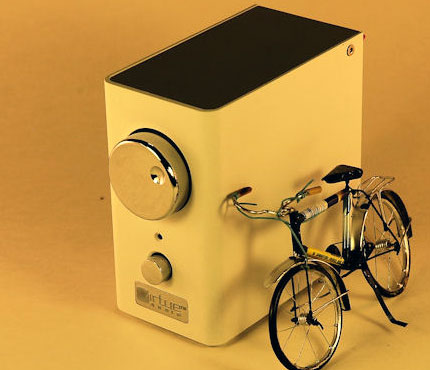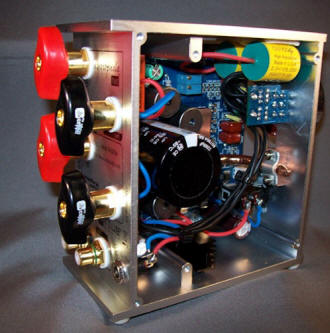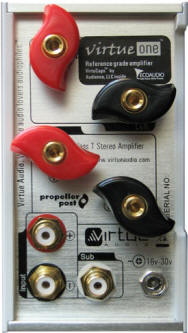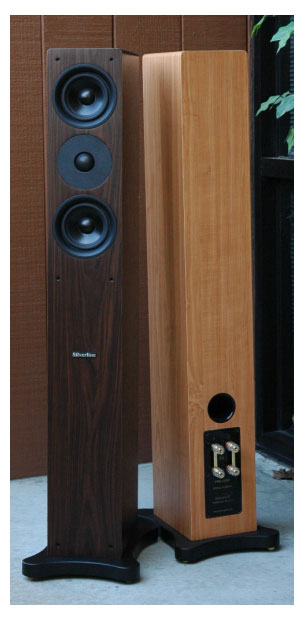|
You are reading the older HTML site Positive Feedback ISSUE 40november/december 2008
The Neoteric Listener
...Virtue
Audio TWO and Silverline Audio Preludes
...and yet another pairing for the music loving
masses.
Long ago, in a garage far, far away, …sat a filthy McIntosh amplifier and an oafish, abandoned DIY speaker, both totally incapable of rendering even the miniest microjoule of music. Why my father never had the amp repaired is no great mystery. An aerospace engineer, he was confident that analyzing exotic compounds scraped from rocket ships made him more than a match for a few capacitors and a soldering gun. Unfortunately, the price of that professional hubris would be a decade's worth of listening to the family Panasonic, but at least there was some reason for this made-in-Japan source of musical discomfort. Less explicable, however, was the massive oak speaker that squatted sourly in the corner, the last depository of baseball gloves, discarded reptile cages, and a curious collection of light switches. This woody mammoth featured dimensions ill-planned and ill-planed, screws as hazardous as they weren't flush, and…and…the biggest woofer you ever laid ears on! This auditory dark star certainly allowed no sound to escape; still, I was tantalized by thought of shattering every window within a half-black (one of the chief goals of high-fidelity at the time; enticing the McGrail sisters across the street was the other). The peevish reality that this speaker was all woof and no bite was beside the point. It could've been loud, and the fact that it just sat there, taunting me like a street mime made it all the more irksome. I connected the speaker to everything but the toaster, but the only sound made from those attempts was my father's terse declaration, "I told you, it just doesn't work." After awhile, I stopped trying, and, eventually, this (somewhat) rectangular wonder of daring don't was hauled off to an elephant's graveyard. But the fascination for what might have been still resonates in the low frequency of my memory, and the elemental truth of musical reproduction remains clear: meters matter. All of which makes reviewing the Virtue Audio TWO reference-grade integrated amplifier such an unexpected pleasure. Roughly the size of an electric pencil sharpener (5"H x 2 3/4"W x 5.5"D) this pound-for-pound bantamweight champ kicks out more than 90 watts per channel of class-T amplification to produce more detail, liquid mid-band, and robust bass than anyone could imagine from such a small package and penny-pinching price ($349). The TWO is designed to be used with one source, so grab your CD player (transport for the sectarians) connect your speakers and desired power supply, plug it in, and you're ready to rock. Or Baroque, or bend-skin, or fandango, whoever you are when you're at home, because this little amp is a genial host to all styles of music. You can plug in your iPod, and it'll work fine. As fine as the universe of music can be when compacted into a bit-sized bullion cube, anyway, and it'll even connect to your sound card for über desk top symphonies. For those who love to build stereo erector sets, you can bi-amp two Audiophile Two's, too, but don't try to bridge them, unless you really like loud explosions and potentially fatal shocks.
All fine and dandy, but can this wee package exceed my great expectations? Anyone duped by advertising during the 100 Watt Wars of the 1970s knows that it's foolish to measure an amplifier by how many people it takes to carry it into the room. Still, many of us have joined the scrum to ogle an amp the size and heat of a Plymouth Duster engine, only to discover that the sound is more funny car than fine fidelity. It's amazing, then, just how effective the TWO can be in producing full, spacious sound. Encased in a sturdy aluminum chassis, the TWO has substantial heft for something so small. This diminutive charmer is available in five colors, but it could always be easily tucked away if pop-art red or yellow ruins your Bauhaus décor. My review model sported a textured yellow powder coat ("Mesa"), bright red propellers, and chrome volume knob, exuding a cheery yellow submarine vibe that added a welcome relief from the self-important grays and blacks of all my other audio equipment. Don't let the good looks fool you, though, for features such as tellurium propeller posts, AuriCap input capacitors, and cryo-treated Auric hookup wire announce that this toy is meant for ages audiophile-on-up. I was fortunate enough to be able to audition this amp in conjunction with a pair of Silverline Audio Preludes loudspeakers ($1200 pr). The high efficiency (sensitivity: 91 dB) and accuracy of the Preludes made them perfectly suited for sounding the merits of the TWO. Connecting the Virtue Audio amp to my Arcam CD 82 and the Preludes (special thanks to Bijan Vahhaji of Definition Audio for the emergency loan of bi-wire Nordost cables), I selected an innocuous test CD, and prepared to take my ease; reclined and refined. Instead of being awash in a bland porridge of strings and clarinet, there was an unsettling hum. Naturally, I assumed that the filter capacitors of the TWO were overmatched by the Devil's rope that is the seventy-year-old wiring in my little beach shack. Undaunted, I loaded up the Preludes, scooped the TWO under my arm, and relocated to a place where sockets and wiring were determined by code, and not by the relative sobriety and competence of long-gone workmen. As a tributary offering for permission to use a much better-sounding room, my friend Paul (who developed his ears as an artist relations rep at Gibson guitars but is diligently ruining them as a prominent sculptor of monstrous steel art projects) demanded that we hook up the Preludes and our CD transport to his Sony integrated AV amplifier. I know, "Look out Mr. Potato Head!" ...But I did it anyway, and the experience offered a quick illustration of how easy it is to recognize superior sound. Connected to the Sony, the Preludes absolutely smoked the Advents that preceded them. No need to print the bar graphs; let's just say that the mini-monitors made substantially better music in every detail. "Better speakers, better sound" was the phrase of the hour and, judiciously avoiding the follow up conundrum of "Are better speakers better, or just different?" we moved on. Having endured countless audiophile bragging contests, and mindful of the "cost of system = defensiveness squared" formula, I respectfully extricated the Sony and substituted the Virtue Audio amplifier. Fortunately, my friend is a gracious type who listens to music for enjoyment not self-definition, so the Virtue Audio amp was a welcome guest. First off, the amp noise was gone, but jiggling the interconnect revealed that the noise was probably caused by a slight solder crack somewhere. As long as you made the connections and left well enough alone, the amp was dead quiet, and it operated perfectly when I brought it back home to see how it would drive my Tannoy stand mounts. The lesson here is that, though it's small and portable, it's not a Bulova Comet transistor radio, so take it easy and show respect! Running a pair of Preludes with the TWO should be standard operating procedures for anyone who has searched for the proper response to, "I don't know, my ______ (take your pick, I've owned them all) sounds pretty good to me!" The TWO produced an immediate and extraordinary improvement to every selection. On "Jesus Gave Me Water," the background harmonies of the Soul Stirrers, clear but anemic on the Sony, were now full, detailed, and warm. That same sense of rich, substantial tone was evidenced in Muddy Waters' seminal blues tune, "I Feel Like Going Home" (Rough Guides). A hard cutting slide guitar played on an overdriven tube amp is a notoriously tricky sound to reproduce satisfactorily, and while I wouldn't say I was sitting next to the standup bass, the TWO at least put me next to the recording console. On Vivaldi's L'Autunno (Supraphon), the soundstage was far more capacious and full of depth, and it was as if the theater curtains had been opened to reveal the entire orchestra. Equally telling was the ability to hear the little things, such as the upper harmonics on the violin as it ascended the scale, or the tautness of the piano, cellos and violas as they quickened the rhythmic pace. It should be mentioned that there were times during very complex passages when the TWO sounded slightly congested, making it a tad difficult to clearly discern which instrument was playing what. This was noticeable during large orchestral pieces, and even during the wail-of-sound crescendo in Coldplay's "Viva la Vida." This quibble must be balanced with the Virtue Audio's ability to deliver music with a fullness and power that made my Arcam integrated seem, well ...pallid by comparison. The picture may not be as clear, but it's bigger and brighter, if you follow me.
The TWO reminds us of the cost effectiveness of well-made audio gear. In this instance, for the price of a good wooden cigar humidor or plush duvet, one can purchase something that significantly improves her or his music experience. Unfortunately, the other economic reality about luxuries (even bargain ones) is that they run in a series, not in parallel. If you buy the Virtue Audio, you'll want the Preludes, and vice-versa. After hearing the Preludes connected to the Sony, my friend was all set to give an early Christmas gift to himself (given the prerequisite spousal approval, of course). His enthusiasm dimmed after hearing them played with the Audiophile Twos. "Those speakers are almost too revealing...[with the TWO] the snare really sounds like a snare. Now, I see it sounded like crap before." Such is the price of the loss of innocence, but $350 is a row of pins for something that transcends the usual its-perfect-for-the office-or-second-room product niche. So it sounds super. Is it the amp or the speakers? Both, and neither. The TWO produced a similar listening experience when connected to my Tannoy Eyris speakers. For stand mounts, these speakers have decent bass extension, and the Virtue Audio amp let me groove right along with James Jamerson's Fender Precision bass on "I Was Made To Love Her" by Stevie Wonder. Piano and women's voices suit the Tannoys best, and the Two's only reinforced these strengths. It can't change chips into fries, however, so if you like your current speakers, the TWO will produce, at the minimum, a warm articulation of vocals, bass, and floor toms. If you want more than that, you'll have to spring for the Preludes, and these, too, represent a superb bargain.
These slim full range mini-monitors (H x W x D: 40" x 5" x 8") weigh in at 60 lbs a pair, and are available in either cherry or rosewood. Aesthetically and sonically, I prefer them with the grills off, and their svelte appearance makes them well suited to any home interior. Owning stand mounts makes me prey to a case of bass-envy, and it's the first thing I list for when auditioning any speakers in my listening room. The fixation quickly gives ways to pleasures more refined, of course, but who hasn't succumbed to low frequency seductions? The Preludes aren't designed to separate brick and mortar, but that doesn't mean that most instruments are lacking in presence or solidity. Too often, speakers convey percussion along a continuum between CRACK! and THUD! Both noises have their uses, of course, but, dammit, I like my zambomba to sound like a zambomba, which is exactly what I get when the Middle East comes to the electronic mountain in the song "Nesatovi" by Beats Antique on their album Collide (CIA). The kalimba and quarkaba are there, as well, although it took some research to ensure that the Preludes were faithfully reporting the characteristic metallic drone and sand sounds. Double bass on "Roustabout" from the same album was authoritative but not boomy, and I appreciated that the musical timbre of each note came through clearly, despite having to fight for air in a clown's car full of exotic instruments. Acoustic guitar is an instrument that I know well, so on a close-mike recording like "Nothing Too Good for a Friend" by Doyle Dokes, I was pleased to hear the staccato picking high on the guitar's neck sound like it should: sharp and thin, but not shrill. On the same recording, the body of the guitar resonated naturally, and even the unnecessary reverb that clouds so many acoustic guitar recordings is as balanced and restrained on these mini-monitors as they are on my stand mounts. Not content to linger on the ground to mid-level floors, the Preludes are more than capable of taking you to the upper level. For the walk up to the observation deck, you'll have to shell out more than the Preludes asking price, but the aluminum/magnesium alloy dome tweeter deftly conveys the upper registers. The sound of the mandolin on Ralph Stanley's "I Am Weary (Let Me Rest) is gratifying, not grating. High harmony voices in the hillbilly style were sweet and coherent, and I never had the feeling that a tonal shade was being lost in the presentation. Depth and soundstage, as mentioned earlier, remained excellent no matter what selection was played, and hours of listening produced no fatigue whatsoever. Well, not to me, anyway, my neighbors might have differing views... The combination of the TWO and the Silverline Audio Preludes really worked well together. For roughly a grand and a half, you can enjoy an audiophile experience that should cost many times the price. They may not please the most discriminating audiophile, but they're perfect for those who love to listen without worrying about the exam. Neither of these products will shatter windows nor salvage the indignities of the past, but they fulfill their promise, which is good enough for me. Virtue Audio http://store.virtueaudio.com Silverline Audio www.silverlineaudio.com
|




